.

Before the coming of digital. Baltasound, Isle of Unst, Shetland. Baltasound Post Office, the most northerly in the UK, with its own special postmark to prove it: photo by David Wyatt, 28 May 2008

Digital TV is coming: Baltasound. These signs, telling of the onset of the switch-off of analogue TV signals next May, look rather out of place in Baltasound and were put up on Sunday morning. The houses in the background are on Springpark Road. One sign only lasted a month and ended up taking the lamp-post with it: photo by Mike Pennington, 20 September 2009

Almost as predicted: Baltasound. When pink adverts warning of the switchover to digital TV were placed on lamp-posts in Baltasound I predicted they wouldn't last the winter. What I didn't expect is that one would take the lamp-post with it -- the stump has been covered in duct tape. The rest of the lamp post is over the wall: photo by Mike Pennington, 22 October 2009

Almost as predicted: Baltasound. The remains of the lamp post carrying the Digital TV ad which lasted little over a month: photo by Mike Pennington, 23 October 2009

Voesgarth, Baltasound: photo by Mike Pennington, 24 October 2009

Recycling centre, Baltasound. Recycling is not always straightforward in Shetland, as there is not enough material to make conventional recycling economic, and shipping material out of Shetland would be counter-productive and use more energy than it would save. Glass (of all colours) is collected and made in 'glasscrete' paving blocks, glass beads for gardens and powdered for use as sand in road-building. The new unit in the right is for recycling clothes: photo by Mike Pennington, 27 October 2009

Petrol pump, Baltasound. Looking towards the voe in the distance: photo by Mike Pennington, 11 May 2009
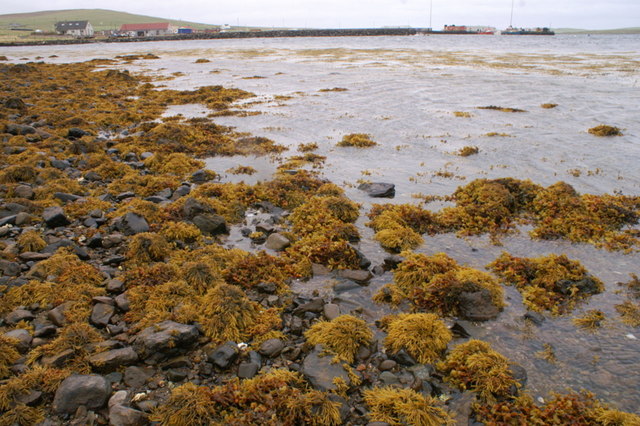
Autumnal shore of Baltasound voe. Even the beaches turn golden-yellow in autumn; Baltasound pier is in the background: photo by Mike Pennington, 26 September 2009

Mussel rafts in the voe of Baltasound: photo by Mike Pennington, 12 September 2007

Remains of a gutting shed, Ordaal, Baltasound. At the beginning of the 20th century, Baltasound. was an enormous herring port, and the voe was surrounded by gutting sheds. Most were made from corrugated iron and this just shows the foundations. Ordaal House is in the background: photo by Mike Pennington, 21 September 2008
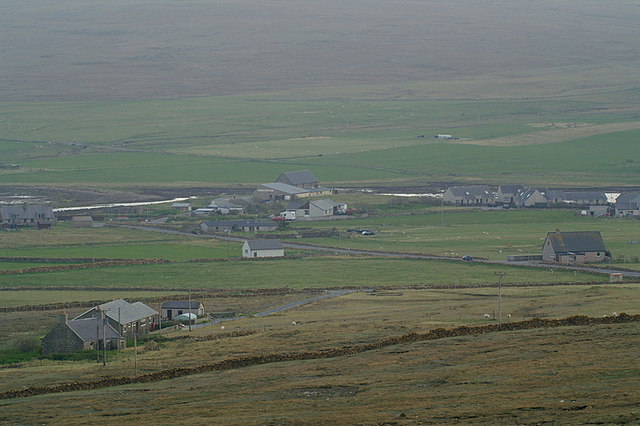
Baltasound from Nikka Vord aka 'I can see my house from here'. Woolvrshoull and Marangu are the closest buildings on the left, with the end of Springpark Road behind. The telephone exchange is the white building in the centre, with Skibhoul and the Post Office behind it. Eagledale is the house on the right, with Daisy Park beyond it: photo by Mike Pennington, 27 April September 2009

Moody sky over Ordale, Baltasound. Autumnal skies at dusk, looking towards the hill of the Keen of Hamar across the voe: photo by Mike Pennington, 30 September 2008

Baltasound from the air. The head of the voe on the left, Buness Loch centre right and Halligarth on the right: photo by Mike Pennington, July 1988

Baltasound telephone exchange. The exchange covers the whole of the north of the island, all numbers beginning 01957711xxx; there is another exchange at Uyeasound for the south end of the island. The hangar at the mothballed airport is in the background: photo by Mike Pennington, 10 October 2009
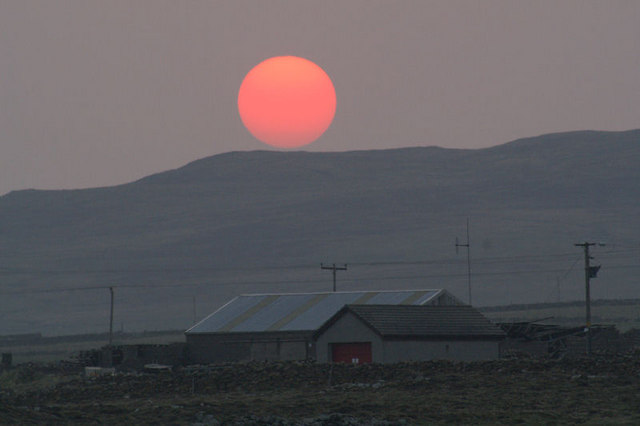
Fire. In the foreground the Baltasound fire shed; in the background a flaming red fireball of a sunset: photo by Mike Pennington, 7 May 2006

Buness from Nikka Vord. The house at Buness is on the left, with the Loch of Buness on the right. The airport hangar is across the voe, with the hill of Virda Field beyond that: photo by Mike Pennington, 27 April 2009

Daala mist, Baltasound. 'Daala mist' is the Shetland name given to the mist which rises from the ground (or from the dales or 'daals') on very calm nights in summer. The house wreathed in mist is Buness house and Hamar is the white house in the distance: photo by Mike Pennington, 25 June 2009
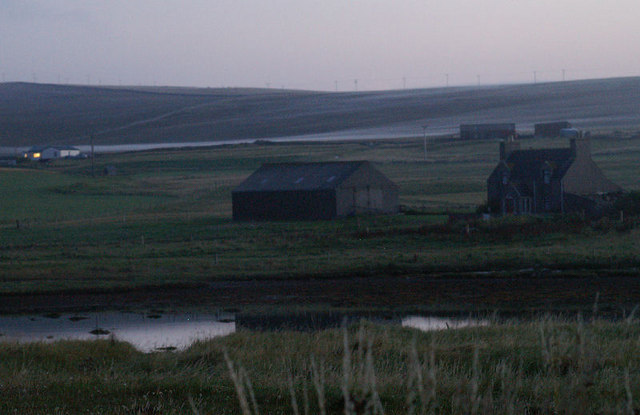
Groundmist, Baltasound. After a glorious sunny day, ground mist forms on the slopes of the Hill of Voesgarth after sunset: photo by Mike Pennington, 8 September 2008

Midsummer sunset over Baltasound. The chimneys are part of the ruined house of Buness Cottage: photo by Mike Pennington, 27 June 2009

Buness House, Baltasound, at dusk. A crescent moon in a pink sky over the voe at Baltasound, from the pier: photo by Mike Pennington, 27 June 2009

Moon at dusk over Baltasound houb. The tide is just ebbing from the houb (lagoon) in the foreground, with the quarter moon reflecting in it; Jupiter is visible to the right: photo by Mike Pennington, 4 November 2008

Moonrise over Ordale, Baltasound. It always amazes how many apparently sensible adults have no idea that the moon can be seen in a blue sky during daylight, although this waxing moon is depicted here after sunset: photo by Mike Pennington, 29 September 2009

View towards Loch of Buness from Halligarth. The island of Balta is in the distance: photo by Mike Pennington, 15 September 2009

Halligarth from Nikka Vord. The plantation dates back to the 1830s and is one of the oldest group of trees in Shetland: photo by Mike Pennington, 27 April 2009
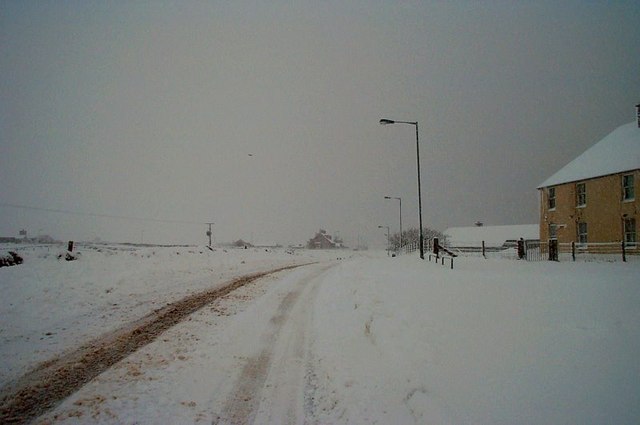
Snow at Daisy Park, Baltasound. On the right are the houses of Seaview and Seafield, which were demolished a few years after this photo was taken: photo by Mike Pennington, 28 December 2001
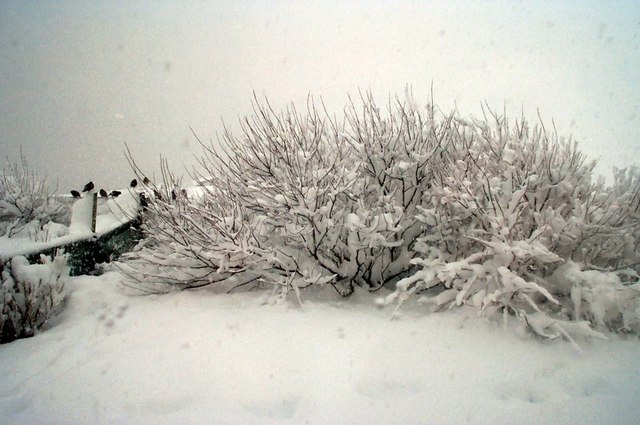
Heavy snow at Baltasound. If there is heavy snow in Shetland it is usually accompanied by strong winds, so this heavy snow softly smothering the branches is unusual: photo by Mike Pennington, 28 December 2001

Road in Baltasound, in snow at night. The road past Daisy Park, looking towards Springpark Road: photo by Mike Pennington, 19 December 2009

Mist over the voe, Baltasound. A very unusual sight, as mist rises off the voe during a sudden and very sharp frost with snow. The phenomenon apparently only occurs in the very rare cases when the sea is significantly warmer than the land. Temperatures in this cold snap fell to -10 Celsius, very cold for Shetland: photo by Mike Pennington, February 2001

Roselea and Muckle Heog from Baltasound. Roselea is the house and Muckle Heog and Little Heog are the hills: photo by Mike Pennington, 9 February 2009

Mist over the voe, Baltasound. With land temperatures dropping exceptionally low and exceptionally quickly, mist starts to rise off the sea, a highly unusual sight: photo by Mike Pennington, February 2001

Sunshine and snow, Halligarth, Baltasound. Snowflakes can be seen falling as the sun in the south still shines: photo by Mike Pennington, 3 February 2010
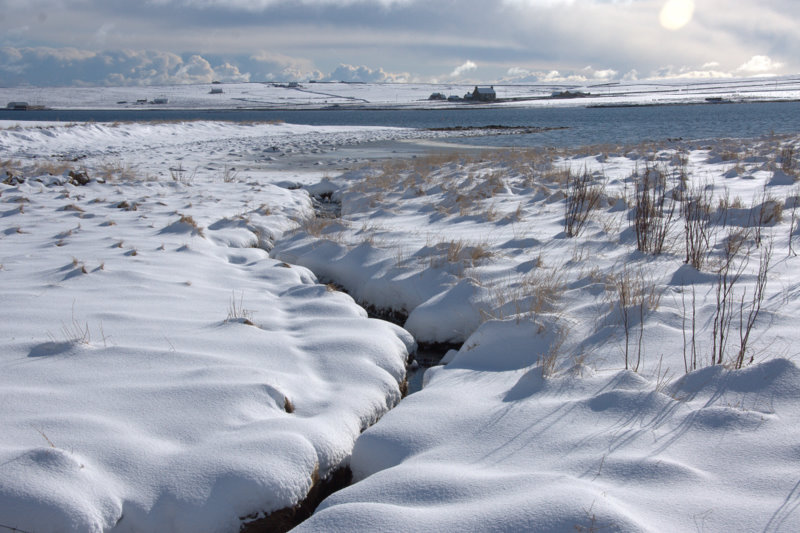
Small burn in the snow, draining into Baltasound voe. Looking across the voe towards Ordale House: photo by Mike Pennington, 23 February 2010

Snow shower passing Baltasound. Looking from the west end of the voe of
Baltasound towards the hill of the Keen of Hamar as a snow shower makes
its spectacular passage down the east coast of Unst: photo by Mike Pennington, 24 February 2010

Snow shower over Buness and Muckle Heog. The view is across the voe at Baltasound towards Buness, the house in the foreground, and Muckle Heog, the hill in background: photo by Mike Pennington, 24 February 2010

Track to an abandoned crofthouse, Baltasound. A tractor has been along the track to collect silage bales: photo by Mike Pennington, 24 February 2010

Snow shower over Buness and Muckle Heog. The view is across the voe at Baltasound towards Buness, the house in the foreground, and Muckle Heog, the hill in background: photo by Mike Pennington, 24 February 2010

Track to an abandoned crofthouse, Baltasound. A tractor has been along the track to collect silage bales: photo by Mike Pennington, 24 February 2010

North shore of Baltasound voe in the snow: photo by Mike Pennington, 2 March 2005

Midwinter dawn, Baltasound. Almost nine o'clock, the sun is just rising over Baltasound, and the waning crescent moon is still bright in the sky. The view is from in front of Skibhoul, looking towards Clingra, the airport and Virda Field: photo by Mike Pennington, 11 December 2009

Midwinter sunrise, Baltasound. The sun is just rising, just before nine in the morning, and emerging above a patch of mist after an unusually calm, still night. The view is towards the houses at Clingera and at the west end of Ordale: photo by Mike Pennington, 11 December 2009

Pigs in the snow, Baltasound. Pigs (or Grice, as they are known in Shetland), are not common in Shetland, although these pigs were part of a pig-farming enterprise which lasted for a few years in these fields: photo by Mike Pennington, 2 March 2001

The sheep was alone in its field and so it was easy to see how it wandered around looking for food, Baltasound: photo by Mike Pennington, 24 February 2010

Sheep feeding on silage in the snow, near to Baltasound. A variety of breed according to my inexpert eye: photo by Mike Pennington, 24 February 2010

Shetland sheep, Baltasound. These sheep are closely eyeing the photographer, wondering if it's safe to return to the feeder which they've just run from: photo by Mike Pennington, 3 February 2010
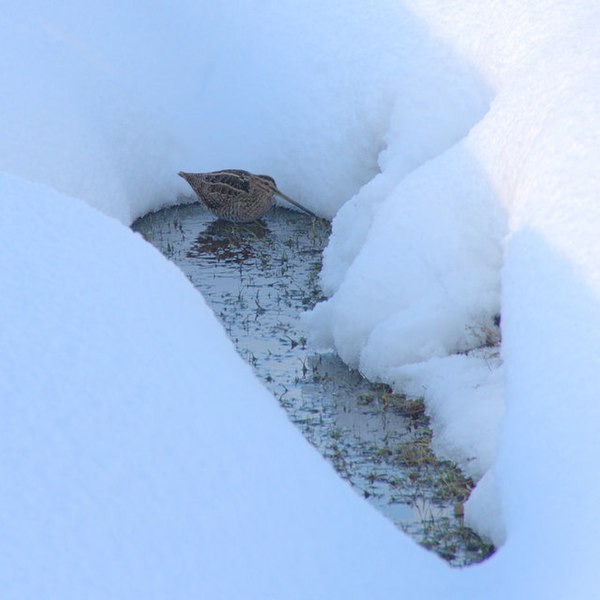
Snipe (Gallinago gallinago) in a ditch, Baltasound. Snow sees birds like Snipe looking desperately for any open water, as in this ditch which has almost filled with snow: photo by Mike Pennington, 24 February 2010

Snow on a drystone dyke, Baltasound. Sticky driven snow from the north has plastered this drystone wall, but the dark marks are not protruding from the snow, but are gaps, presumably where the stones are too far apart so the snow has not been able to bridge the gap: photo by Mike Pennington, 22 February 2010

Snowy crows, Baltasound. Hooded Crows (Corvus cornix) in the first snow of an early March snowfall: photo by Mike Pennington, 1 March 2006

Black Swans (Cygnus atratus), the Houb, Baltasound. Black Swans are native to Australia, but these two escapees which spent a several days on the Houb in Baltasound attracted a lot of attention: photo by Mike Pennington, 4 May 2001

Greylag Geese (Anser anser), Baltasound. Greylag Geese only started breeding in Shetland, on Unst, about 25 years ago, but several hundred pairs now breed in the islands: photo by Mike Pennington, 11 May 2009









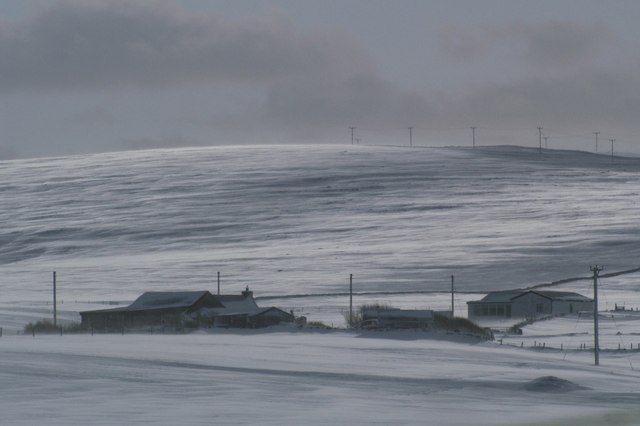
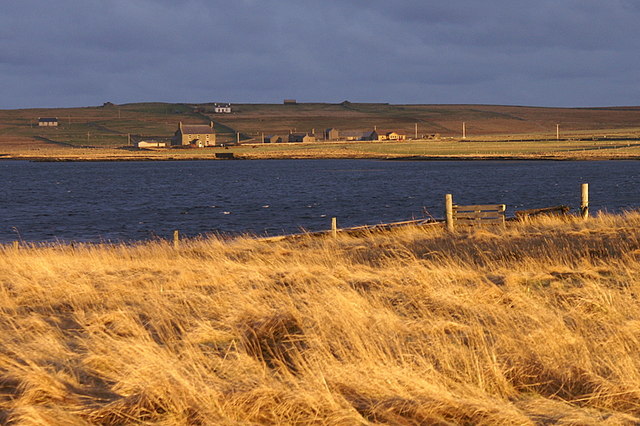



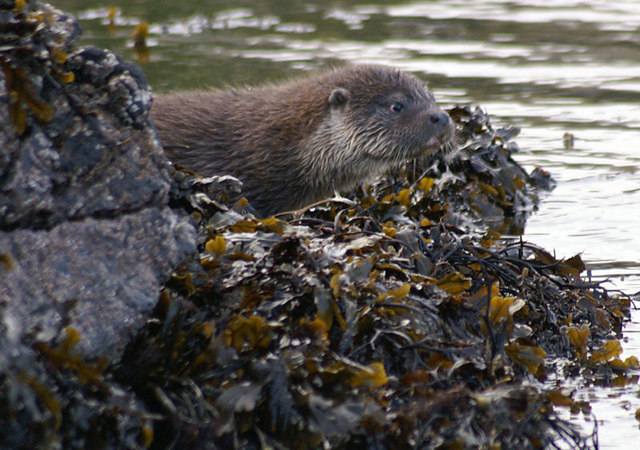

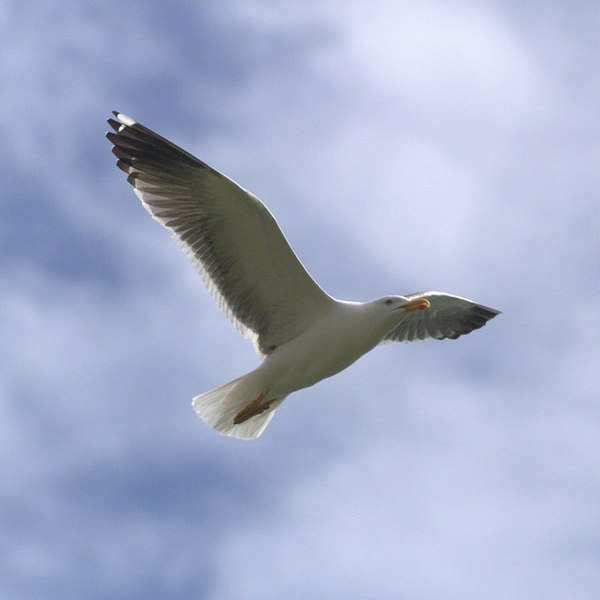
I've never been to the Shetlands but have long been fascinated by them.
ReplyDeleteI suppose there's nowhere wholly apart now.
Well, this seemed about as close as one could get to being about as far from everything as one could get.
ReplyDelete(Should it go without saying that I think Mike Pennington, who took all these photos save the "establishing shot" at top, is a marvelous photographer?)
A brisk day in Baltasound.
ReplyDeleteThe photos are great - he knows the environment intimately, all the changes in the weather. That big red Sun is beautiful.
ReplyDeleteThese images moved me very much.
ReplyDeleteAn isolation fostered by sensible neglect.
Jeremy Grantham believes we're in the biggest historical bubble in history, one that will leave human populations in scattered remote desolation, not unlike that suggested by these broad wasted landscapes. I should not say "wasted" since there was never very much to sustain human development in the first place. It reminded me too of this picturesque little BBC drama Doc Martin in a tiny British seaside village, where the shrinking populace finds itself braced against the rumbling encroachments of a larger reality.
We always feel as if we're on the "edge" of something. And being "on edge" too.
This comment has been removed by the author.
ReplyDeleteCheers for the tip off, Dalriada.
ReplyDeleteThat's what I call a bus shelter!
Many thanks Curtis, Colin and Duncan.
ReplyDeleteCoincidentally, during the eight and a half months I have now spent on meditative nocturnal excursions to Baltasound, in search of peace and quietness of mind far from the madding traffic roar, it did become plain that there is one feature of Baltasound which has made the place -- yes, and this is no lie -- a global tourist destination.
And that is Bobby's Bus Shelter, so-called because in 1n 1996, at the age of seven, young Bobbie Macaulay -- one of (then) two regular users of the bus shelter -- became the poster lad for a local campaign to save the shelter from demolition; and over the years this led to much outside-world publicity attendant upon the colourful annual thematic refurbishings, each involving the introduction of a fresh mass of amenities that might make it the world's only five-star bus shelter.
All that led up to the making of this second Baltasound post.
Glass Box
That was due to go up yesterday, but for a wobbly moment upon my automobile-damaged underpinnings, a nasty household fall and a day of bleeding, bandaging and grumbling.
In any case... in this "companion" post (can a bleak evocation of remoteness and solitude be said to have a companion really?), I've deliberately left out much of the impression of cuteness and adorability given in several of the annual bus shelter thematics, the bright yellows and purples and computers and tv sets and mini-library and stuffed animals and adorable hamsters & c., all hinting of a brightness and cheer belied by the view through the glass.
Thank you, Tom. I travel through your images to places I've never been, and probably never will be. It's ok. It's another kind of travel you offer anyway. The kind that doesn't pollute. Sorry to hear that accident still, of course, in you. – Donna
ReplyDeleteTom,
ReplyDeleteIncredible pictures from one Mike Pennington and yes, about as close to being as far away from everything as one could get -- a bit like West Marin don't you think, until we get to all that snow (lovely to think such a place is still there).
3.14
light coming into fog against invisible
ridge, bird slanting toward pine branch
in foreground, sound of wave in channel
physical out of which, that
is not primarily what
distance, moment in balance,
levels light and dark
silver circle of sun rising above ridge,
fog on horizon to the left of the point
Donna, well, it's the one form of travel I can manage any more -- and relatively safe, at that.
ReplyDeleteNo one was ever felled by a speeding picture. And too, as you suggest, work of the imagination does not leave a carbon footprint.
("You call that work?")
Steve, yes, West Marin -- if West Marin were to detach from California overnight, and by morning relocate northward to the Bering Straits.
(The statistics for number of hours of sunshine per month are pretty staggering for Baltasound -- something like 15 minutes, for the entire month of December, if I remember correctly.)
(By the by, the recycling bins that go largely unused because there's so little junk to recycle -- could there be any better advertisement for a place inhabited by humans?)
ReplyDeleteGreat photos. "Pigs in the Snow" is a tune waiting to be written.
ReplyDeleteTerry,
ReplyDeleteFor all we know there may well be a spirited reel called Pigs in the Snow.
This region is known for its traditional fiddlers. Here is a 1973 recording of a man who was a legend among them:
Gibbie Gray (1909-1989), Shetland Fiddler of Unst.
"Gibbie, as he is affectionately known, had too small a croft to be able to support him and consequently spent most of his life at sea. At the age of fourteen he worked at inshore halibut fishing in fourareens -- and when this fishing failed he joined the merchant service and travelled around the world.
"He lost his best fiddle when he was torpedoed while serving on The Highlander in World War II.
"On D-Day his vessel was blown up by a mine just outside Aberdeen. There were fourteen Shetlanders amongst the crew and five were lost.
"When war ended he worked for a time in salvage operations in England for five years before again trying his luck at fishing, this time for herring on board a seine-netter based on Burra Isle. After that he worked until retirement at the RAF camp in Unst and spent his spare time fishing for lobsters around the entrance to Baltasound.
"He learned his fiddling from his father, who also played, and from his mother who was among the few Shetland women who played the fiddle. If for most of his working life he was away from Unst, he nevertheless preserved a distinct Unst style from his boyhood days.
"His father played with his fiddle held low on his left arm but in 'just the same' style as his son, although whilst Gibbie was used to being accompanied by a piano, his father never played to accompaniments."
-- Peter Cooke: The Fiddle Tradition of the Shetland Isles
Thanks for this, Tom. Beautiful playing, reminiscent of Cape Breton fiddling. I bet my dear friend Brendan Mulvihill is familiar Gibbie. I will inquire.
ReplyDelete